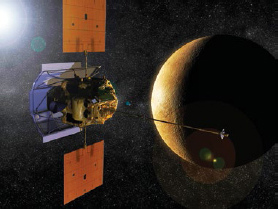2011
MESSENGER at Mercury
Mercury is the most difficult to observe of the classical planets because it is always close to the Sun. The planet has also been stubbornly resistant to spacecraft exploration, partly because of its challengingly hot thermal environment, where sunlight can be 5 to 10 times more intense than at Earth.
Only one space mission explored the innermost planet during the twentieth century. Mariner 10, launched in 1973, performed three close flybys past Mercury in 1974–1975. About half the planet was photographed, revealing a lunar-like, cratered surface and large-scale tectonic features that point to an early, molten surface that cooled and contracted over time. Mariner 10 also discovered that Mercury has a strong magnetic field, likely related to the planet’s large, partially molten core.
These intriguing discoveries compelled planetary scientists to propose a dedicated Mercury orbiter mission, which NASA selected for launch in 2004. After gravity-assist flybys of Earth, Venus, and three flybys of Mercury itself, the Mercury Surface, Space Environment, Geochemistry, and Ranging mission (MESSENGER, a contrived acronym in honor of Mercury’s mythologic role as the messenger of the gods) finally braked into a successful, elliptical orbit around Mercury in March 2011.
MESSENGER has completed mapping the entire planet, and made exciting discoveries about ancient Mercurian volcanoes, craters, and tectonic landforms before running out of maneuvering fuel and crashing onto the planet in 2015. Mission scientists determined that bright spots seen at Mercury’s poles in Arecibo radar images are indeed permanently shadowed, ice-filled impact craters, rather than some strange geochemical anomaly. Indeed, the poles are icier than originally thought because ice fills many small, previously unresolved shadowed craters as well.

MESSENGER’s discoveries will also help influence the planning and operation of the next Mercury mission, the European Space Agency’s BepiColombo orbiter, planned to launch in 2018 and settle into Mercury orbit in 2025.
SEE ALSO Mercury (c. 4.5 Billion BCE), Search for Vulcan (1859), Arecibo Radio Telescope (1963), Lunar Highlands (1972).
The first photograph taken from Mercury orbit, captured by the NASA MESSENGER spacecraft (seen in an artist’s rendering in the inset) on March 29, 2011. The bright rayed crater near the top is called Debussy; the region from the middle to bottom of the photo is near Mercury’s south pole.
